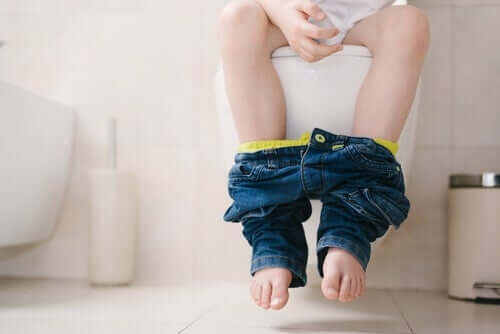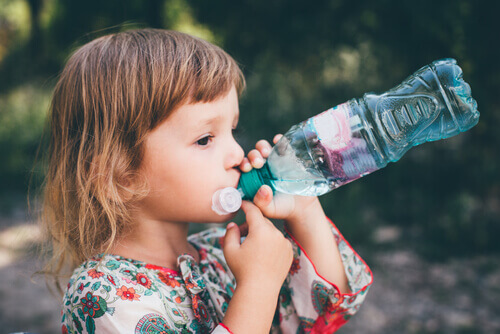Constipation in Children: What Causes It and How Is It Solved?

Constipation in children is a very common condition. Do you want to know what it consists of and how you can treat it? The keys of how to help your children in those moments are below.
As a mother, you’ve surely heard of constipation in children or experienced it with your own kids. During the first years of life, it’s very normal for children to suffer from it, so you don’t have to worry.
Children with difficulty defecating will find it painful to do so, so they’ll try to avoid it, making the problem worse.
You can go to your pediatrician when you consider that your child may be having problems with infantile constipation. The sooner they return to having normal bowel habits, the better for your child’s health and well-being.
Causes that can promote constipation in children
Episodes of constipation in children can be due to various factors such as:
- A diet that’s low in liquid and fiber. Water is essential in children’s diets, as is fiber, which they can get from fruits and vegetables. Although it hasn’t been proven that it has a direct relationship with constipation, it’s best for children to consume water and fiber, as it softens the stool.
- Abuse of astringent foods. These foods tend to favor episodes of constipation, so their consumption should be moderate. Some astringent foods are bananas, rice, apples, chocolate, and refined sugars found in candy and sweets.
- External factors. Children react to the environment with their whole body, so a traumatic family event such as a separation or a death can cause episodes of constipation. Also, the beginning of school or kindergarten can be the cause of this symptomatology.

- Mandatory bathroom visiting habits. When teaching kids to relieve themselves on the potty or toilet, many parents make the mistake of forcing them to use the bathroom. Physiological needs shouldn’t be forced, but rather voluntary and whenever the child needs it.
- Lack of orderly times for meals. The danger of snacking that many children suffer is reflected in a poor diet during the important meals of the day.
If it’s painful for them to go to the bathroom, they’ll avoid it. And if they avoid it, it will make the problem worse.
But what’s considered constipation in children?
Constipation depends a lot on each child and their age. According to the Spanish Association of Pediatrics, for constipation to be considered in children that are at least four years old, at least 2 of the following criteria must be met for 2 consecutive months:
- Less than 3 bowel movements a week
- At least one episode of fecal incontinence per week
- Retentive postures or attitudes to avoid defecation
- Painful defecation
- Stools of a large diameter in the rectum or that are palpable at the abdominal level
- Excessively voluminous stools
When it comes to children under four years of age, the criteria are similar, although above all the absence of defecations or the child’s pain when trying to expel them predominate.
There are also children who do relieve themselves, but incompletely, which makes their stools grow larger and it becomes increasingly painful to pass them.
If any of these cases coincide with what you suspect is happening to your child, go to your pediatrician.

How can constipation in children be treated?
Although the best advice will be provided by your pediatrician, here are some tips that can help your child.
- Changes in diet. Increase the water in their diet, instead of soda or sugary juices. They should also eat more vegetables and fruits to increase their fiber intake. Fruits such as kiwi or plum also have laxative effects. Also, cook with olive oil, as it favors transit and is healthier.
- Sports. Physical activity favors intestinal transit and prevents a sedentary lifestyle. Encourage your child to play sports or do any physical activity that he or she likes.
- A regular pattern of visits to the bathroom. When you’re teaching, sit them down for a few minutes after meals, but without forcing them to have a bowel movement. Educate them not to hold in their poop and to go to the bathroom every time they need to.
And remember, you should never medicate your child without the proper prescription. If necessary, go to your pediatrician for advice on which medication is the most appropriate.
Constipation in children is a very common condition. Do you want to know what it consists of and how you can treat it? The keys of how to help your children in those moments are below.
As a mother, you’ve surely heard of constipation in children or experienced it with your own kids. During the first years of life, it’s very normal for children to suffer from it, so you don’t have to worry.
Children with difficulty defecating will find it painful to do so, so they’ll try to avoid it, making the problem worse.
You can go to your pediatrician when you consider that your child may be having problems with infantile constipation. The sooner they return to having normal bowel habits, the better for your child’s health and well-being.
Causes that can promote constipation in children
Episodes of constipation in children can be due to various factors such as:
- A diet that’s low in liquid and fiber. Water is essential in children’s diets, as is fiber, which they can get from fruits and vegetables. Although it hasn’t been proven that it has a direct relationship with constipation, it’s best for children to consume water and fiber, as it softens the stool.
- Abuse of astringent foods. These foods tend to favor episodes of constipation, so their consumption should be moderate. Some astringent foods are bananas, rice, apples, chocolate, and refined sugars found in candy and sweets.
- External factors. Children react to the environment with their whole body, so a traumatic family event such as a separation or a death can cause episodes of constipation. Also, the beginning of school or kindergarten can be the cause of this symptomatology.

- Mandatory bathroom visiting habits. When teaching kids to relieve themselves on the potty or toilet, many parents make the mistake of forcing them to use the bathroom. Physiological needs shouldn’t be forced, but rather voluntary and whenever the child needs it.
- Lack of orderly times for meals. The danger of snacking that many children suffer is reflected in a poor diet during the important meals of the day.
If it’s painful for them to go to the bathroom, they’ll avoid it. And if they avoid it, it will make the problem worse.
But what’s considered constipation in children?
Constipation depends a lot on each child and their age. According to the Spanish Association of Pediatrics, for constipation to be considered in children that are at least four years old, at least 2 of the following criteria must be met for 2 consecutive months:
- Less than 3 bowel movements a week
- At least one episode of fecal incontinence per week
- Retentive postures or attitudes to avoid defecation
- Painful defecation
- Stools of a large diameter in the rectum or that are palpable at the abdominal level
- Excessively voluminous stools
When it comes to children under four years of age, the criteria are similar, although above all the absence of defecations or the child’s pain when trying to expel them predominate.
There are also children who do relieve themselves, but incompletely, which makes their stools grow larger and it becomes increasingly painful to pass them.
If any of these cases coincide with what you suspect is happening to your child, go to your pediatrician.

How can constipation in children be treated?
Although the best advice will be provided by your pediatrician, here are some tips that can help your child.
- Changes in diet. Increase the water in their diet, instead of soda or sugary juices. They should also eat more vegetables and fruits to increase their fiber intake. Fruits such as kiwi or plum also have laxative effects. Also, cook with olive oil, as it favors transit and is healthier.
- Sports. Physical activity favors intestinal transit and prevents a sedentary lifestyle. Encourage your child to play sports or do any physical activity that he or she likes.
- A regular pattern of visits to the bathroom. When you’re teaching, sit them down for a few minutes after meals, but without forcing them to have a bowel movement. Educate them not to hold in their poop and to go to the bathroom every time they need to.
And remember, you should never medicate your child without the proper prescription. If necessary, go to your pediatrician for advice on which medication is the most appropriate.
All cited sources were thoroughly reviewed by our team to ensure their quality, reliability, currency, and validity. The bibliography of this article was considered reliable and of academic or scientific accuracy.
- Barboza, F. M. (2005). Evaluación y tratamiento del estreñimiento en niños. Colombia Médica, 36(2 Supl 1), 10-15. http://colombiamedica.univalle.edu.co/index.php/comedica/article/view/346
- Camarero Salces, C., & Rizo Pascual, J. M. (2011). Diagnóstico y tratamiento del estreñimiento en el niño. Información Terapéutica del Sistema Nacional de Salud, 35(1), 13-20. https://medes.com/publication/66819
- Casasnovas, A. B., Martín, F. A., Quintana, L. P., Allué, I. P., Ruiz, F. S., & Calderón, V. V. (2011, January). Recomendaciones para el tratamiento del estreñimiento funcional. In Anales de Pediatría (Vol. 74, No. 1, pp. 51-e1). Elsevier Doyma. https://www.sciencedirect.com/science/article/pii/S1695403310004819
- De la Torre Mondragón L, Hernández Vez G. E. (2014). streñimiento funcional en pediatría. Acta Pediat Mex 2014;35:411-422.
- Ruiz, F. S., Gilbert, J. J., Calderón, P. B., & Jaime, B. E. (2010). Estreñimiento y encopresis. Acuña QM, Alonso FM, Álvarez CJ, Argüelles MF, Armas RH, Barrio MA y cols. Protocolos Diagnóstico-Terapéuticos de Gastroenterología, Hepatología y Nutrición. 2nd ed. España: Ergón SA, 53-65. http://www.aeped.es/sites/default/files/documentos/estre_encopresis.pdf
- VV.AA. (n.d.). Estreñimiento y encopresis. Protocolos diagnóstico-terapéuticos de Gastroenterología, Hepatología y Nutrición Pediátrica SEGHNP-AEP. 53- 65. [En línea].
This text is provided for informational purposes only and does not replace consultation with a professional. If in doubt, consult your specialist.








